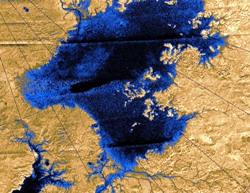Findings suggest the surface of Saturn’s largest moon may have undergone a recent transformation, writes Jennifer Chu
Geoscientist 22.08 September 2012
 Caption: Image from the Cassini mission shows river networks draining into lakes in Titan's north polar region. Credit: NASA/JPL/USGS
Caption: Image from the Cassini mission shows river networks draining into lakes in Titan's north polar region. Credit: NASA/JPL/USGS
For many years, Titan’s thick, methane- and nitrogen-rich atmosphere kept astronomers from seeing what lies beneath. Saturn’s largest moon appeared through telescopes as a hazy orange orb, in contrast to the other, heavily cratered moons in the solar system.
In 2004, the Cassini-Huygens spacecraft penetrated Titan’s haze, providing scientists with their first detailed pictures of the surface. Radar images revealed an icy terrain carved out over millions of years by rivers of liquid methane.
Very little is known about its geological past. Now researchers at MIT and the University of Tennessee at Knoxville have analysed Titan’s river networks and determined that in some regions, rivers have created surprisingly little erosion. Either erosion on Titan is extremely slow, or something may have recently wiped out older landforms.
“It’s a surface that should be much more eroded if the river networks have been active for a long time” says Taylor Perron, Assistant Professor of Geology at MIT. “It raises some very interesting questions about what has been happening on Titan in the last billion years.”
Titan is around four billion years old. But judging by the crater count, one might estimate its surface to be between 100 million and one billion years old. What might explain this low crater count? Perron says the answer may be similar to what happens on Earth.
“We don’t have many impact craters on Earth” Perron says. “One reason is that Earth’s continents are always eroding or being covered with sediment. That may be the case on Titan, too.”
Images generated by the Cassini spacecraft, similar to aerial photos though with much lower resolution, are flat, depicting terrain from a bird’s-eye perspective, and giving no information about elevation or depth. So, going simply on the branching pattern alone, Perron and MIT graduate student Benjamin Black mapped 52 prominent river networks from four regions.
They then compared the images with a model of river network evolution developed by Perron. This depicts the evolution of a river over time, given variables such as the strength of the underlying material and the rate of flow through the channels. The comparison revealed that the moon’s rivers most closely resemble the early stages of a typical terrestrial river’s evolution.
“They’re on the long and spindly side” Black says. “You do see some full and branching networks, and that’s tantalising, because if we get more data, it will be interesting to know whether there really are regional differences.”
However, comparing Titan’s images with recently renewed landscapes on Earth, including volcanic terrain on the island of Kauai and recently glaciated landscapes in North America, is strongly suggestive. River networks there bear a strong similarity of form to Titan’s, suggesting that geologic processes have reshaped the moon’s icy surface in the recent past.
“It’s a weirdly Earth-like place, even with this exotic combination of materials and temperatures” Perron says. “And so you can still say something definitive about the erosion. It’s the same physics.”
Reference
- Estimating erosional exhumation on Titan from drainage network morphology. Benjamin Alexander Black, J. Taylor Perron, Devon Burr, Sarah A Drummond JOURNAL OF GEOPHYSICAL RESEARCH, doi:10.1029/2012JE004085